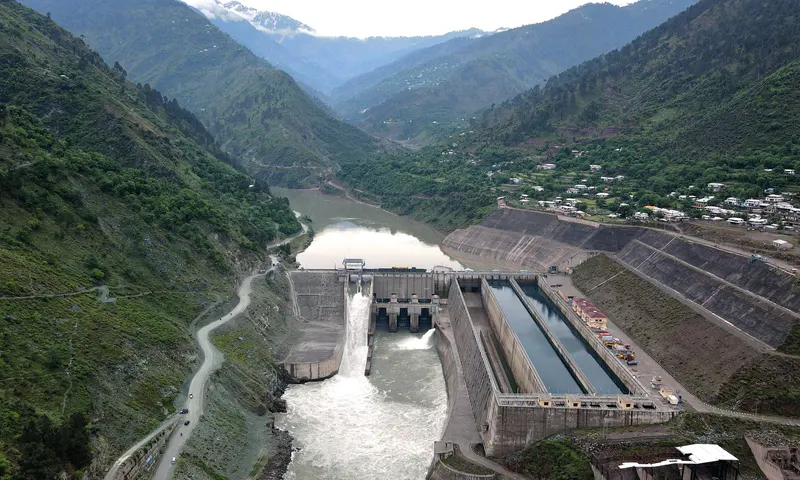A number of China Pakistan Economic Corridor (CPEC) projects are making renewed progress as the CPEC, a flagship project under the China-proposed Belt and Road Initiative (BRI), enters its next phase, helping the country to alleviate energy shortage and empowering its economic growth.
Entering 2024, CPEC projects have achieved new progress.
The Karot hydropower project, a 720 megawatt (MW) hydropower plant developed on the Jhelum River in Pakistan and the first ever large-scale hydro power project under the BRI, has generated a total of 3.1 billion kilowatt hours of electricity in 2023, China Three Gorges Corporation, which invested and is leading construction of the project, announced on its website on January 22.
In December, two China-donated projects, including a seawater desalination plant and the upgrade of the Pak-China Friendship Hospital, were inaugurated in Gwadar district of Pakistan’s southwestern Balochistan province.
The desalination plant will provide 5,000 tons per day of potable water to help address a severe drinking water shortage, while the Pak-China Friendship Hospital boosted its capacity to 150 beds from the original 50.
Projects progressing
At the Karachi Nuclear Power Plant, the K2 and K3 units that both use Hualong One, China’s third-generation nuclear power reactor with full intellectual property rights, are churning out a combined 20 billion kilowatt hours each year, satisfying the production and residential electricity use of 2 million people while saving energy equivalent to 6.24 million tons of standard coal, the Global Times learned from China National Nuclear Corporation.
In July last year, Unit 5 (C-5) of the Chashma Nuclear Power Plant broke ground, marking the 7th nuclear reactor exported from China to Pakistan.
Pakistan is on the right side of history by standing with China as the game changer CPEC’s second phase will unveil record development and economic uplift in the country, the Associated Press of Pakistan reported in December, quoting Senator Mushahid Hussain Sayed, Chairman of Senate Standing Committee on Defense.
Launched in 2013, the CPEC is a corridor linking Gwadar port with Kashi in Northwest China’s Xinjiang region, highlighting energy, transportation and industrial cooperation.
In its first phase, the CPEC had more than 8,000 MW of power generating capacity added to the Pakistani national grid. More than 800 kilometers of highways were built while more than 800 kilometers of fiber-optic cable were laid. More than 200,000 jobs were created, according to data from the Pakistani Embassy in China.
To jointly promote the development of the CPEC, China and Pakistan held the Fourth Meeting of the CPEC Joint Working Group on International Cooperation and Coordination in Islamabad in late January.
The next phase of CPEC will be advanced in a multi-prong fashion, with progress in connectivity, industrialization and agriculture, Pakistani Ambassador to China Khalil-ur-Rahman Hashmi told the Global Times in a recent interview. Projects including the optimization of the ML-1 (Mainline-1) railway project and the realignment of the Karakoram Highway (KKH) are expected to see concrete progress, the envoy said.
Present at the joint working group meeting, Hashmi revealed that both sides expressed satisfaction at the pace of progress that is being achieved on CPEC as a whole and Pakistan and China welcome the third-party participation in line with CPEC’s spirit of economic collaboration, shared prosperity and shared gains.
Both sides have agreed to extend the CPEC into third parties, the ambassador said, noting that other workable areas could include mining, agriculture and information technology. The special economic zone can be a platform through which the third-party investment could come in, said the envoy, noting that more efforts will be made to ensure the security and safety of Chinese personnel and projects.
Chinese observers said as a witness to the strong relationship enjoyed by the two countries, the CPEC has developed in the past decade to be a key link and lifeline of the BRI, benefiting bilateral economic and trade cooperation as well as economic cooperation in the South Asia region.
The economic corridor’s role in poverty alleviation, improving people’s livelihood and empowering the local populace is significant, Song Wei, a professor at the School of International Relations and Diplomacy at the Beijing Foreign Studies University, told the Global Times on Thursday.
“Moving forward, the CPEC as a flagship of BRI, will see more connectivity and infrastructure projects to be built to further the economic corridor’s function as a key vehicle for economic cooperation and energy security, as the BRI enters a high-quality development phase in the new era,” Song said.
Baseless accusations
The ambassador dismissed the so-called “debt trap” narratives used by some Western media outlets to frame CPEC projects, saying such allegations are no more than “propaganda or political opinion and what people have not heard is facts.” People who indulge in such theories will have to see things in perspective of the developing countries, the envoy noted.
The ambassador noted that the traditional channels to secure funding for big infrastructure and energy undertakings in developing countries were done through organizations such as the World Bank and the Asian Development Bank, but the funding available within these organizations has gone down over a period of time.
“The UN sustainable development goals are an excellent vision, yet there is no financing available, or indeed, the level of financing [required] is not there,” Hashmi said. “So I think instead of criticizing China, China should in fact be appreciated because it has made that financing available to so many countries in the developing world.”










